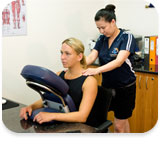How do you enable your employees to be not only deeply productive, but loyal? Engaged, but low stress? Collaborative and communicative, but also focused? For decades, companies have been searching for ways to help their employees lead better lives, whether through anti-smoking initiatives, nutrition programs, or fitness plans. But stress continues to grow. In the new always-on culture of work, it’s not just the body that needs a break. There is a new way companies are learning to support both their employees and their business goals – an approach that helps reduce stress, improve engagement, and make for happier employees.
Companies are choosing mindfulness
Mindfulness meditation helps to reduce stress, increase focus, and improve relationships, while also promoting a positive workplace. When we think of learning to meditate, it’s common to picture something inaccessible, but mindfulness can be found in conference rooms across the country. Mindfulness, when practiced not just by an individual but by a company, can lead the whole organisation to becoming more resilient and more productive. And the science behind it continues to mount.
Impacting the bottom line Reducing stress for a healthier business
Stress comes with significant costs for businesses. Reports suggest that stress results annually in as much as $300 billion in lost productivity, almost $200 billion in stress-related-illness expense, and one million workers being absent every day.
Research shows that mindfulness meditation can reduce stress and can have a significant impact in the workplace by helping people regulate emotions, changing the brain to be more resilient to stress, and improving stress biomarkers. A Headspace study has shown that with just 10 days of Headspace, participants experienced a 14% decrease in stress. A Harvard study even showed that meditation can have a longer-lasting effect on stress than a vacation. Participants of the study were measured for stress levels 10-months later, and the vacationers’ stress levels had returned to baseline, whereas the meditators maintained their reduced stress levels. Impacting the bottom line Reducing stress for a healthier business Workers in many high-stress occupations, such as healthcare professionals, call-centre employees, and bankers, have experienced health benefits such as decreased stress after mindfulness training.
One study found that after 8 weeks of mindfulness training, nurses had significantly decreased stress levels and improvement in general health. The same improvements were sustained 4 months after the training.
Employees of a call centre working for a financial institution experienced decreased stress after listening to two short meditation sessions daily for 5 weeks. Bonus: The clients of these employees actually had increased satisfaction levels over time.
A European study involving a diverse sample of workers (including industrial clerks, bankers, hospitality service employees, retail salespersons, nurses, teachers, social workers, and psychologists) showed that after 10 days of self-guided mindfulness exercises, participants reported decreased levels of emotional exhaustion.
In fact, in Aetna’s first year of implementing a mindfulness program, healthcare costs fell 7%, saving the company over $6 million. Aetna’s study also found that mindfulness increased job effectiveness, with employees gaining an average of 62 minutes of productivity per week. Aetna estimated that additional hour of productivity was worth $3,000 per employee per year.
Stress might seem like a motivator, but happy employees are actually more productive than unhappy ones — 12% more productive according to one study. What’s more, another study showed that happier sales people sold 37% more than their unhappy counterparts.
Improving engagement and job satisfaction
When mindfulness becomes a regular habit throughout an office, it permeates through all the processes and routines, and it’s been shown that organisations practicing mindfulness perform more reliably than other similar workplaces. In fact, a Gallup study found that companies with engaged employees outperformed those without by more than 200%.
In a 2012 study that measured the effect a mindful leader had on employee performance, it was shown that supervisor mindfulness reduced employee emotional exhaustion and actually improved employee performance and engagement. A mindful supervisor was positively related to employee satisfaction. More research still needs to be done on how mindfulness affects teams, but for a number of companies, research has pointed to reduced turnover, higher customer satisfaction and increased loyalty, and improved financial performance.
Mindfulness training for “workaholics” even resulted in less working time, but no change in job performance. They were just able to be more productive during the hours they were at work.
And that’s hardly a surprise: engaged employees are more productive than less engaged employees. A Gallup survey of a diverse group of employees showed that teams with high employee engagement were 21% more productive. And it turns out, mindfulness helps foster the characteristics that enhance engagement, like positivity, emotional balance, decreased stress, and better relationships with coworkers — some of the core tenets of simply being satisfied with your job. In fact, in one study using Headspace, nurses who meditated for 30 days had significant improvements in job satisfaction.
Promotes collaboration
A brilliant team only succeeds when they can work together. A study involving both small and medium sized businesses found that the companies with the most engaged employees (a byproduct of collaboration) have 26% less turnover and 20% less absenteeism, not to mention a 65% increase in stock value.
It’s also been shown that even if only one side of a relationship is practicing meditation, the relationship will benefit. All of these benefits add up to better working relationships across organisations. In one case study done by A Head for Work, 34 mental health trust clinicians and staff underwent mindfulness training, and 93% reported improved relationships with their coworkers.
In fact, 45 studies on mindfulness in the workplace have shown that mindfulness meditation leads to better relationships between colleagues, which then improves collaboration and resilience within the company during times of increased stress, and this was shown across several industries. And it’s not just at work: mindfulness meditation has been shown to make meditators more compassionate and enjoy more satisfying personal relationships.
Improves cognition
Studies show that after practicing four sessions of either meditation or simply listening to an audio book, those who meditated showed reduced fatigue and anxiety. Not only that, but the people who meditated also showed improved working memory, executive functioning, and sustained attention when assessed on mood, verbal fluency, and memory. Better recall and a better attitude can go a long way on challenging projects.
Enhances creativity
A stressed mind is closed off to opportunity, and when hundreds of stressed minds are shut off, your company could lose out on significant gains. A survey done by Forrester Consulting for Adobe found that businesses that embraced creativity enjoyed greater market share, outnumbering their competitors 1.5 to 1, and that applies outside of traditionally creative industries. How we approach a set of data, how we tackle a challenging client, even how we approach scheduling all take creativity. Research into problem solving has shown mindfulness causes a break in the habitual verbal-conceptual processing, indicating there is a direct relationship between creativity and mindfulness. In a separate study, scientists also found that mindfulness promoted divergent thinking, leaving the door open for new ideas.
Reducing company stress, improving relationships across departments, and lowering overall costs all benefit the business, but mindfulness also has great impact on individual benefits. Mindfulness isn’t something that requires talent. It’s a skill you can learn like any other. Mindfulness meditation allows people to be more aware of their thoughts, and thus more aware of and able to control their reactions to those thoughts.
References
Walton, G., Carr, P. B., & Howe, L. C. (n.d.). Cues of working together fuel intrinsic motivation and can contribute to the solution of collective action problems. PsycEXTRA Dataset. doi:10.1037/e578192014-274
Desteno, D., Lim, D., Duong, F., & Condon, P. (2017). Meditation Inhibits Aggressive Responses to Provocations. Mindfulness. doi:10.1007/s12671-017-0847-2
Lim, D., Condon, P., & Desteno, D. (2015). Mindfulness and Compassion: An Examination of Mechanism and Scalability. Plos One, 10(2). doi:10.1371/journal.pone.0118221
Khaddouma, A., Gordon, K. C., & Strand, E. B. (2016). Mindful Mates: A Pilot Study of the Relational Effects of Mindfulness-Based Stress Reduction on Participants and Their Partners. Family Process, 56(3), 636-651. doi:10.1111/ famp.12226 Building the Case for Mindfulness in the Workplace. (n.d.). Retrieved April 12, 2018, from http:// themindfulnessinitiative.org.uk/publications/buildingthe-case
Zeidan, F., Johnson, S. K., Diamond, B. J., David, Z., & Goolkasian, P. (2010). Mindfulness meditation improves cognition: Evidence of brief mental training. Consciousness and Cognition, 19(2), 597-605. doi:10.1016/j.concog.2010.03.014 What Makes Creative Companies Outperform Their Competitors? (2017, June 30). Retrieved April 12, 2018, from https://www.creativityatwork.com/2015/01/16/ creativity-drives-business-results/
Ostafin, B. D., & Kassman, K. T. (2012). Stepping out of history: Mindfulness improves insight problem solving. Consciousness and Cognition, 21(2), 1031-1036. doi:10.1016/j.concog.2012.02.014
Colzato, L. S., Ozturk, A., & Hommel, B. (2012). Meditate to Create: The Impact of Focused-Attention and OpenMonitoring Training on Convergent and Divergent Thinking. Frontiers in Psychology, 3. doi:10.3389/fpsyg.2012.00116 Highlights: Workplace Stress & Anxiety Disorders Survey. (n.d.). Retrieved April 12, 2018, from https://adaa.org/ workplace-stress-anxiety-disorders-survey#
Carsley, D., Khoury, B., & Heath, N. L. (2017). Effectiveness of Mindfulness Interventions for Mental Health in Schools: A Comprehensive Meta-analysis. Mindfulness. doi:10.1007/ s12671-017-0839-2
Farb, N. A., Anderson, A. K., & Segal, Z. V. (2012). The Mindful Brain and Emotion Regulation in Mood Disorders. The Canadian Journal of Psychiatry, 57(2), 70-77. doi:10.1177/070674371205700203
Gelles, D. (2016). Mindful work: How meditation is changing business from the inside out. NY, NY: Mariner Books.
Weick, K. E., & Roberts, K. H. (1993). Collective Mind in Organizations: Heedful Interrelating on Flight Decks. Administrative Science Quarterly, 38(3), 357. doi:10.2307/2393372
Vogus, T. J., & Iacobucci, D. (2016). Creating Highly Reliable Health Care. ILR Review, 69(4), 911-938. doi:10.1177/0019793916642759
Ndubisi, N. O. (2012). Mindfulness, quality and reliability in small and large firms. International Journal of Quality & Reliability Management, 29(6), 600-606. doi:10.1108/02656711211245683
Vogus, T. J., & Welbourne, T. M. (2003). Structuring for high reliability: HR practices and mindful processes in reliability-seeking organizations. Journal of Organizational Behavior,24(7), 877-903. doi:10.1002/job.221
Martin, J. (2012, September 06). Employee Brain on Stress Can Quash Creativity And Competitive Edge. Retrieved April 12, 2018, from https://www.forbes.com/sites/ work-in-progress/2012/09/05/employee-brain-onstress-can-quash-creativity-competitive-edge/ #62075174b3e9
Bond, S., & Shapiro, G. (2014, November). Tough At The Top? New Rules of Resilience for Women’s Leadership Success. [PDF]. For Business Sake Consulting. Sponsored by Nationwide, Vodafone
Reb, J., Narayanan, J., & Chaturvedi, S. (2012). Leading Mindfully: Two Studies on the Influence of Supervisor Trait Mindfulness on Employee Well-Being and Performance. Mindfulness, 5(1), 36-45. doi:10.1007/ s12671-012-0144-z









 About Us
About Us

